Solemn Gestures on the Sandy Ground. Tchiloli in São Tomé and Príncipe
Photos: Author
São Tomé and Príncipe, an archipelago on the Equator, boasts one of the most curious performances of popular imagination. Tchiloli is the fruit of cultural (and at times violent) encounters and creolisation. It is a delightful ethnodrama/ethnotheatre that unites music, movements and 16th century texts in one ceremony.
Tchiloli has been practised in São Tomé and Príncipe for a long time, but has suffered relative decline in recent years. At the basis of tchiloli is the representation of Madeiran poet Baltazar Dias’ version of The Tragedy of the Marquis of Mantua and the Emperor Charlemagne (1664), usually on the island of São Tomé, and of Auto de Floripes, on Saint Lawrence’s Day (15/8), on the island of Príncipe. Tchiloli is inspired by Castilian novels, which in turn had benefited from influences dating back to the Carolingian cycle of the 11th century. The story is about Don Carloto, son and heir of the Emperor Charlemagne, who murdered his best friend, Valdevinos, nephew of the Marquis of Mantua, in a hunt. This passionate crime (motivated by Don Carloto’s passion for Sibyl, Valdevinos’ wife) led the two families to debate issues of law, justice and governance. The emperor was faced with the dilemma of choosing between national interest and paternal love, and his son was executed in the imperial fortress in the end.
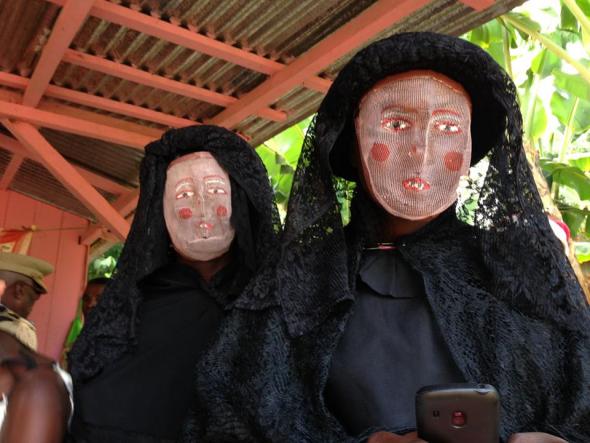 To suit a place that never had a monarchy, the historical saga is presently adapted and new judicial and contemporary elements are added. In an overlap of times and aesthetics, solemn and sumptuous gestures are re-enacted on the sandy ground.
To suit a place that never had a monarchy, the historical saga is presently adapted and new judicial and contemporary elements are added. In an overlap of times and aesthetics, solemn and sumptuous gestures are re-enacted on the sandy ground.
Tchiloli takes place on the beaten earth of a backyard or public square. It is an open stage that is at once didactic and communal. The play is observable from all angles. At one end of the stage, a high court stands tall on wooden stakes and is covered with palm branches, representing the imperial palace. At the other end of the stage, a ground-level, rustic hut of green leaves represents the lower court of the bereaved Mantua family. A small coffin placed on a chair in the middle of the stage symbolises the deceased Valdevinos.
Tchiloli is commonly played at religious, popular or public events during the gravana (dry season) with the intention of attracting tourists. Groups are invited to perform at such events for a fee.
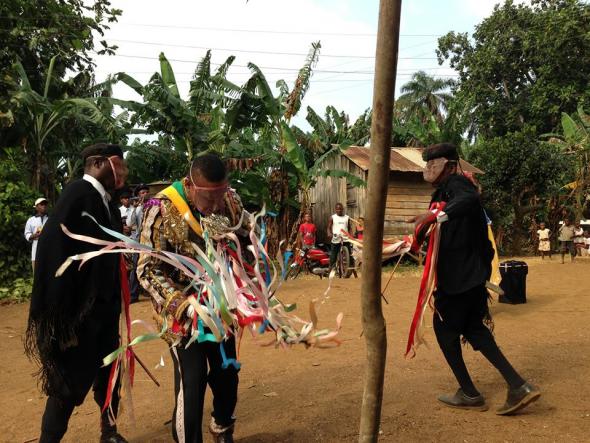
I first attended tchiloli excerpts at the Biennale of Art and Culture of São Tomé and Príncipe (in 2008 and 2011). In 2013, we filmed the performance of the Florentina de Caixão Grande group for a brief feature in the Naturalistas em África documentary produced by Terratreme.
Tchiloli groups, known as “tragedies”, have about thirty members each and hail from different localities, making up a mosaic of island belongings. In recent years, there are fewer and fewer tragedies while shows are becoming increasingly sporadic. The groups experience great difficulties. The “actors”, usually farmers and fishermen, play the same characters for life. The father passes his character on to his son. One such actor tells me that he is already “the 5th dynasty of Don Carloto”. Tchiloli is waning because of the disinterest of the new generation in preservation. Thus, despite being an emblematic cultural heritage, tchiloli is threatened by extinction. In order to survive, tchiloli will have to be constantly recreated. It must not be a mere crystallized folklore for the tourist to see.
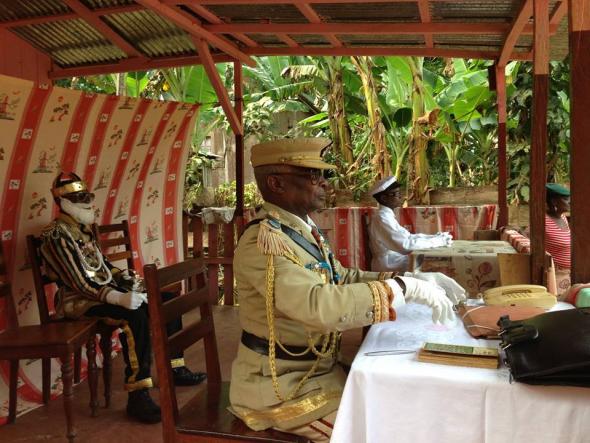
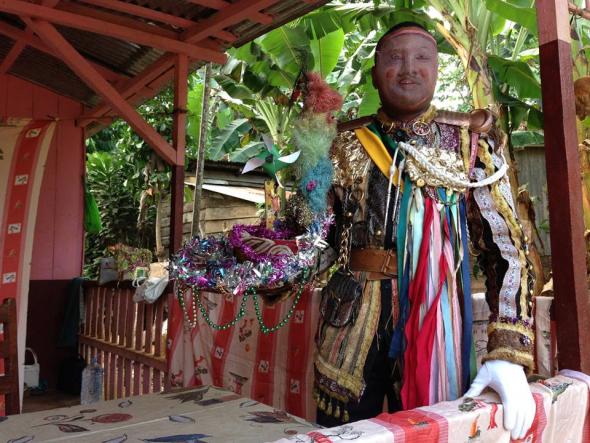
It is said that tchiloli is derived from the Portuguese word tiroliro, referring to a transverse flute that is played during the show. There may be an etymological connection between tchiloli and teoria, meaning theory (Paulo Valverde 1998; Rougé 1990). Theory evokes a certain distant act. Theory is the apprehension of a long parcel of territory from a considerable distance, according to Richard Rorty. Tchiloli plays with distance and proximity, apprehending and observing. In the course of a performance that can last up to five hours, scenes go back and forth between the high court and lower court, between judgment and condolences. The actors move around and gesture all over the space in overlapping scenes. There are moments of suspense with monothematic music. Such music is of vital importance to the show because it not only gives rhythms to the dances and mimicking but also underline and propitiate the characters’ acts and movements. The orchestra plays flutes, drums and sucalos ( native instruments in the form of a basket with seeds inside). The actors enter and leave the immediate stage, wait for their turn nearby in plain sight, get dressed in improvised tents, and take care of other matters if necessary.
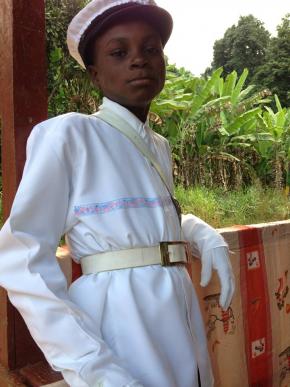 The spectator (referring to any one of the spectators) has an active role. In anthropological terms, he or she is a participant-observer. None of the various phases of the show is to be neglected, but it is not uncommon for the show to be interrupted by conversations between the performers and the audience or by a meal. Integrated in the stage, the spectator stands, with arms crossed, or sits on the floor, and sees fragments of the show for entertainment. As a rule, he will have seen the same performance countless times and so knows by heart all the lines and pauses and prefers to pay attention to the details. He also collaborates with the actors, by contributing, imitating and commenting, drawing references to the country’s social and political events, even making use of bad language, satirising social vices and political abuses.
The spectator (referring to any one of the spectators) has an active role. In anthropological terms, he or she is a participant-observer. None of the various phases of the show is to be neglected, but it is not uncommon for the show to be interrupted by conversations between the performers and the audience or by a meal. Integrated in the stage, the spectator stands, with arms crossed, or sits on the floor, and sees fragments of the show for entertainment. As a rule, he will have seen the same performance countless times and so knows by heart all the lines and pauses and prefers to pay attention to the details. He also collaborates with the actors, by contributing, imitating and commenting, drawing references to the country’s social and political events, even making use of bad language, satirising social vices and political abuses.
Children imitate the movements of Reinaldo or Captain Montalvão. They mimic the femininity of the queen’s ladies (the female roles are played by men as in the Vincentian drama). Chairs are reserved for guests from outside the locality, national dignitaries or foreigners. Paulo Valverde discusses the fascination of outsiders who watch tchiloli and become enchanted by the blending of elements of the Middle Ages, Renaissance and Europe on the African Equator. For them, tchiloli provides an “optical temporal illusion”, like some sort of temporal projection in an improbable setting.
The perennial debates about the origin of tchiloli on the islands (when it came about and in what context, how the legacy was passed on, how it developed and changed, conditions of appropriation and positioning, etc.) are not the biggest concern here (see Seibert 2009). According to Valverde, it was through mobilisation by the colonial administration cultural department that presentations of tchiloli began in the 1960s and 1970s. Shows were seen in colonial festivals and competitions, where groups competed for originality claims (respecting a common canon and accentuating subtle differences in accessories and movements). There were also (limited) international performance arrangements, which led many participants to commit themselves to rehearsals (often walking long kilometres) in the hope of travelling and knowing the world (which was the only chance to do so for many islanders). On the basis of scenic elements such as word, sound, light, props and scenery, tchiloli, a cultural manifestation of island-bound populations, gained theatricality and ethnographic uniqueness.
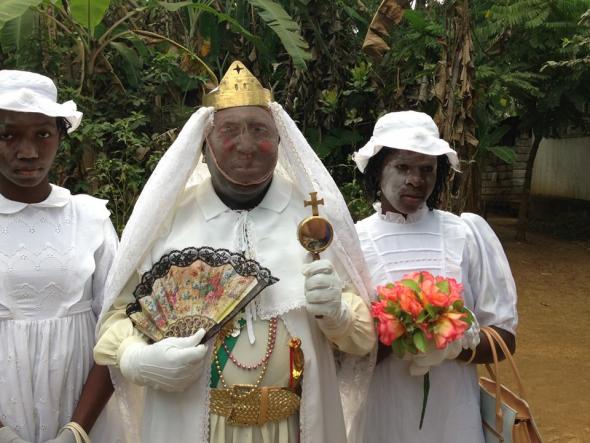
Reading the thesis of Ana Pais (2015) on the theory of affections in theatre, I was reminded of Schechner’s and Turner’s concept of communitas. Related to the artistic and political function of performance, distinct from the idea of community, communitas refers to unmediated relationship established between ritual participants – actors and spectators – at the periphery of social norms (Turner apud Schechner 2002, 71). The encounter promoted by theatre/performance implies a transformation – political, social, and artistic – derived from the ritual, one that generates a sense of communitas. The anthropological paradigm is at the origin of Performance Studies. We talk of the cultural experience of theatre and of how the body is prominent in ritual performances.
The relationship with the audience is one of communication in which the spectator is an interpreter, or of cultural practice in which the spectator is a participant, and with reference to Victor Turner’s work on ritual, we are urged to think of theatre as a social practice inscribed in a broad cultural context and to reflect on non-artistic practices in the light of the new operative concept of performance (Pais 2015, 19).
The ethnologist Jean Yves Loude (2012) also stresses that, among other things, tchiloli is an ancestral cult, a performance that brings out the communal force of group catharsis, and is, in effect, a collective therapy. It is prized not only for its expressivity but also for its endurance in history. The author explains that, although we cannot ascertain when tchiloli was first staged exactly, it eventually gained shape and was performed in 16th century Portuguese by a group of barely literate people over long duration. In tchiloli, the ancestors are summoned and duly recognised by the living actors. The dead are appellated in what is almost a voodoo ritual, one that unites the entire community, dead and alive.
Gerhard Seibert’s long-time research on tchiloli can be read in the article titled “Charlemagne on the Equator: The Introduction of Tchiloli in São Tomé”. Accordingly, each tchiloli tragedy was by tradition associated with a certain local group of the Forro people, who lived in spatial segregation from the contracted Angolan labourers (Cape Verdeans and Mozambicans came only from 1903 and 1908 onwards, respectively). The living and working conditions were extremely trying, but the Forro people had access to cultural practices (tchiloli, socop dance) and religious practices (brotherhoods) that the Angolans labouring on the farms did not have. Generally speaking, it was not possible for the Angolans at the time to participate in tchiloli, for tchiloli was only introduced in São Tomé at the end of the 19th century.
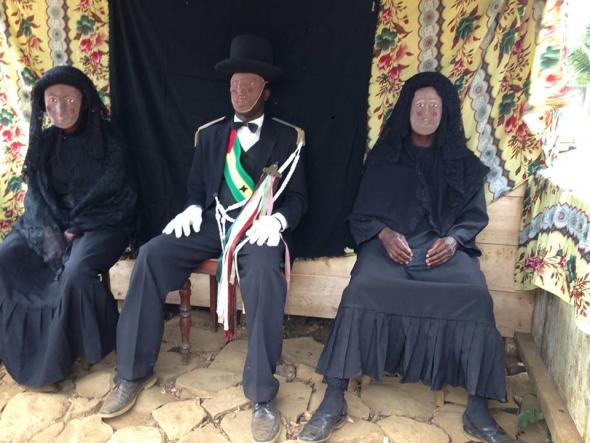
The actors are pragmatic performers who respect the stories told by the elders and bear the torch of generational transmission. Costumes and accessories play a central part and are the most striking elements, visually and ideologically (Valverde 1998, 224). They are made by local people and families who reuse and recycle materials such as ribbon twists, upholstery, chocolate wrappings, mirrors, gilt, domestic gloves, glasses, polychrome sculptures from the last century, telephones and typewriters. For Gründ (2006), these rustic materials are renewed and in the process gain new symbolic value tending to the luxurious. The objects are sacralised, empowered by performance, historical preservation, and the passing on of a role from one person to another. It is worth remembering that such objects were once symbols of power in moments of contact with foreigners, with whom the natives exchanged mineral or agricultural products for industrialised products. Trivial items used to symbolise power in the communities (e.g., mirrors and beads). In tchiloli, military power is felt in uniforms and white gloves; the power of the Administration is felt in suits, the telephone, typewriter, glasses, briefcase; the power of knowledge is felt in student ceremonial ribbons. Masks, smaller than the face, are mosquito nets painted white, plus two eyes and a mouth, adding to the mystery of all the staging. The wardrobe, presenting an interesting anachronism, is continuously renewed and new accessorial pieces are added from time to time.
Tchiloli embodies a story of blood and justice. Santomeans have appropriated tchiloli and transformed it into a unique spectacle. Tchiloli symbolises immeasurable popular ingenuity and constitutes a form of cultural resistance, the survival of which depends on constant enactments and the maintenance of a sustainable relationship with the place and with the participating audience. We need to protect this cultural heritage urgently, starting by practice.
See photo gallery about Tchiloli.
Bibliography
GRÜND, Françoise (2006) Le Tchiloli de São Tomé and Príncipe. Paris: Éditions Magellan et Conpagnie.
LOUDE, Jean-Yves (2012, Mar 3) “O Contributo Africano: Valorizar o Resultado Optimista de Uma História Péssima”. Público. Entrevista a Marta Lança.
PAIS, Ana (2015) Comoção: Os Ritmos Afectivos do Acontecimento Teatral. Tese de doutoramento em Estudos de Teatro, Faculdade de Letras da Universidade de Lisboa.
ROUGÉ, Jean Louis (1990) “Pourquoi Tchiloli,” Internationale de l’Imaginaire, N.º 14. Maison des Cultures du Monde.
SCHECHNER, Richard (1994 [1973]) Environmental Theatre. London and New York: Applause.
———– (1985) Between Theater and Anthropology. Philadelphia: University of Pennsylvania Press.
SCHECHNER, Richard (2002) Performance Studies: An Introduction. London and New York: Routlege.
SEIBERT, Gerhard (2009) Carlos Magno no Equador: A Introdução do Tchiloli em São Tomé (Artigo originalmente publicado na revista Latitudes. Cahiers Lusophones. nº 36, Outubro de 2009, pp.16-20). Disponível em: https://www.buala.org/pt/palcos/carlos-magno-no-equador-a-introducao-do-tchiloli-em-sao-tome)
VALVERDE, Paulo (1998) “Carlos Magno e as Artes da Morte: Estudo Sobre o Tchiloli da Ilha de São Tomé”, Etnográfica 2(2), 221-250.